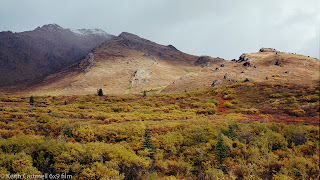During a photo road trip last summer I'd stopped at Film Experience in Longview, Alberta, and picked up several different kinds of film when I bought the camera. I exposed a roll of the Visions3 back in May 2022, and loved the results, but mostly I was about putting an inexpensive roll of film through the camera. I wanted to try it again with autumn colours.
During another road trip I picked up another roll, and exposed it October 2022 during the peak of autumn colour. So far so good. What I'd forgotten was that the lab I use has a 2 roll minimum for processing this film. It needs the ECN-2 process, rather than the regular C-41. Oops.
I wasn't going to drive out to Longview for one roll of film. Neither could I find any film in Calgary that needed that processing. I ended up buying a bunch of film to get the free shipping, and it arrived in a few days. Now I have lots of film for both cameras, probably enough for all winter, maybe longer.
In the meantime, I'd put a couple rolls of Kodak Gold 200 through the camera, and loved the results! I finished those off, and loaded a second Visions3. By now the autumn colours were essentially gone, and I worked some street and nature scenes. I got stalled with a half dozen exposures to go.
Then I was watching a video about a person running a weekly film contest. Every Saturday the idea was to submit a photo taken within the previous week. The logistics of joining that were pretty daunting, in terms of exposing a roll and getting it back from the lab within a week. But something he said struck me, about getting the photo you wanted to send in, and still having some of the roll left. Just go shoot it! Experiment. Play, take photos of anything. So I set the camera up on our front lattice in the evening and tried light trails.
When it comes to comparing Visions3 to Kodak Gold 200, I don't see a lot of difference. Give the films lots of light and the images come out with bright, and true to life colours. Exposure gets a bit more tricky in more subdued light.
But first, for new readers that care about the background details. If you just want to see the photos scroll down. I'm using a Canon 7 with a Canon 50mm f1.4 lens. Mostly I expose for the shadows with an iPhone meter and let the highlights take care of themselves. The lab is Paul Stack, and I think he does a great job. I digitize the negatives using a Canon T6i with a Canon 100mm f2.8 L macro lens. Inverting from negative to positive is with Negative Lab Pro (v 2.3.0 and yes I know there are updates available, and that whole thing is another issue entirely), and I generally tend to have a light hand on editing. I like the image to look like film, and I don't try to make it look like a digital image. My thinking is that if you want it to look digital, the capture it on digital, and if you want it to look like film, capture it on film. Then into Lightroom to deal with any dust spots or hairs, cropping, or correcting rotation. All this practice and I often still hold the camera slightly rotated off horizontal.
The hardest thing about the whole process is loading the cut film strips into the carrier to go onto the light source. These two rolls were slightly cupped from edge to edge, making it a bit tricky to load. I've been thinking about getting some small sheets of Anti Newton Ring glass but it's stupidly expensive at the places I've looked so far. Since the last film I digitized was 35m, the camera was already in the right spot on the copy stand. A moment to double check focus and I was off.
When I said I used a light hand during Negative Lab Pro editing, I'm not kidding. Play with the white point a bit too much and yellow turns orange and the sky gets really dark. As a photo that might look nice, but anyone living in Calgary knows the trees don't go quite that colour. As shot, the colour tends to be quite vivid. I missed capturing our red peony with this film. I've got another two rolls of it, so maybe I'll wait till it blooms next spring and capture that.
1. We had a fabulous autumn! We get lots of gold and yellow in the trees, and this film picks that up wonderfully. The film loves lots of light.
Overall I love the colour! However, the ECN-2 processing is more expensive, and there's that two roll minimum. Once I do the two rolls next year, I probably won't get any more. For sure I wouldn't get anymore if I could reliably get the Gold 200 in 35mm. I bought out all that Walmart had, and I hate shopping at Walmart. They didn't think they would get anymore since it was already back ordered.
What's in the camera now, you ask? Black and white Acros II 100. I got a bunch of it, just barely expired for cheap.





















































